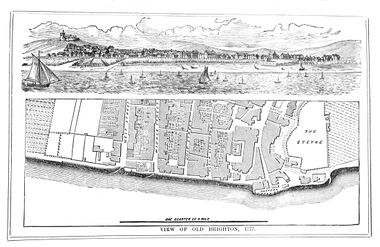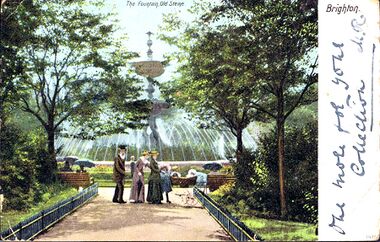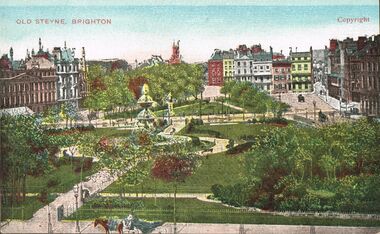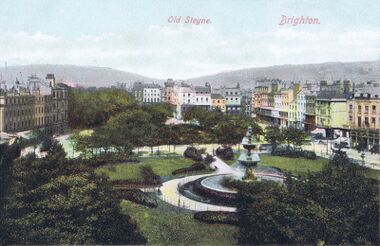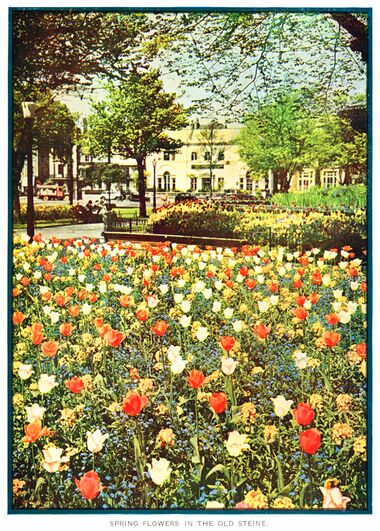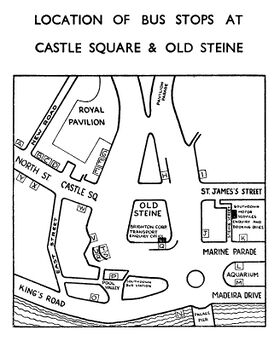Category:Old Steine
1777: map of Brighton, showing "THE STEYNE" to the East. Some of the space was later absorbed into what became the Pavilion estate. [image info]
~1903: "The Fountain, Old Steine", postcard [image info]
????: View looking North, showing what appears to be the statue of George IV in its original position, at the site now occupied by the Brighton War Memorial [image info]
~1905-1908: Colorised aerial photograph of Old Steine. Where's George? This image suggests that the statue may have been moved before WW1 [image info]
1935: Spring Flowers in the Old Steine [image info]
1962: map of old Steine, showing the Southdown Bus Station [image info]
Old Steine (also known as The Steine, and The Steyne) is an area of open land in Brighton where the floor of the valley enclosing Brighton approaches the waterfront. It links Grand Parade with the seafront at the location of Brighton Palace Pier.
The current Steine is effectively cut into two where North Street from the west links up with St James Street from the east. The southern part ("southern enclosure") is approximately squarish and is laid out as Steine Gardens. The northern part ("northern enclosure") is a triangle or wedge and is less accessible.
Origins
The word "Steyne" or "Steine" means "Stone", and the area was the stony patch of ground just to the West of old Brighton, at the foot of the valley where the river that ran down the valley floor, underground (making The Level too boggy to build on) emerged and ran into the sea.
The area's large stones were supposedly made good use of by the local fishermen as a place to dry their nets, and the right of the fishing community to continue making use of the area helped to preserve at least part of the area from being built on. This meant that the main roadway into Brighton, London Road followed by (eventually) Grand Parade, ended in a nice wide open area, with hotels for travellers and the subsequent Kemp Town being built to the East of the Steine, rather than on it.
1826 description:
THE STEYNE
This is a delightful and spacious lawn, deservedly admired for its promenade, and to which thousands of our fashionable visitors resort, when the heat of the meridian sun has been succeeded by the gentle and refreshing breezes of a summer evening.
The assemblage of beauty and fashion, that promenade the eastern side of the Steyne, at this period of the day, united with the charming view of the sea, on which floats many a buoyant skiff, and the gentle strains of music, sweeping along the undulating breeze, present a degree of fascination, difficult to be described. Formerly this was an irregular piece of common land, and used by the inhabitants for boat-building, making and drying nets, stowage of coals, waggons, timber, vehicles, carts, and lumber, of every description; but in the year 1793 it was improved at the joint expence of the Prince of Wales and the Duke of Marlborough; its nuisances began gradually to disappear, shortly afterwards it was levelled and inclosed in two plots, the foot way, from Castle Square to St. James Street, dividing it; since which time it has been further improved, and recently additional plots have been enclosed: the pavement has been considerably widened, these are now covered with nature's robes, and are often crowded with the gay throng.
A pedestrian statue of His Majesty by Chantry is about to be erected on a handsome pedestal on the northern enclosure. The expense of which will be defrayed by a voluntary subscription of the inhabitants, as a token of their gratitude, for the patronage bestowed upon the town, by that illustrious individual.
The Steyne is surrounded by handsome buildings, many of which are of a superior order, of this number is the one on the south west side of Castle Square, which was erected in 1804 for Mrs Fitzherbert, who occasionally honours it as her residence. Near to this is the elegant mansion, built by the Right Honourable George Hamilton, celebrated by the title of Single Speech Hamilton; afterwards it was the residence of the late amiable and benevolent Lady Ann Murray, now the property of Thomas Harrington Esq. On the north west of Castle Square, leading from the western entrance of the Pavilion, to the south east front of the Palace, stand a superb site of buildings, the property of W. Boxall Esq., however splendid their appearance, is it cannot but be regretted, that the view of the sea from the Pavilion should be so obstructed, which, we think, cannot but be extremely obnoxious to His Majesty; on the eastern side of the Steyne stands Mr. Lucomb's Library, of which in another place some account will be given.
— , J. Whittemore, , 1826
1838 description:
OLD STEYNE SQUARES AND PROMENADES
The celebrated spot called the Steyne, was formerly a piece of waste land, and used by the inhabitants for boat-building, net-making, and as a depository for heavy goods; it has, however, long been surrounded by handsome buildings. About thirty years ago the lawn was divided, levelled, and enclosed, leaving in the middle a passage from North Street and Castle Square to St. James's Street; it is only within the last few years, that a carriage road has been formed across, previous to which, carriages had to make a circuit round by the Albion Hotel, to pass from St. James's Street into North Street. In the northern enclosure is now placed the celebrated BRONZE STATUE of his late Majesty George the Fourth, executed by Chantrey, and erected in the year 1828, the necessary funds amounting to £3000, having been previously collected by the contributions of the inhabitants and visitors.
The name of the "Steyne" is supposed to be derived from the Roman way called Steyne Street, Stane Street, or Stone Street, which passed through the town of Steyning, and also gave name to that town. Traces of the road have been occasionally discerned: it was constructed of stones of irregular size, and varied from twenty to thirty feet in width, while in some places it has been found to be about four and a half deep.
— , Saunders, , The Stranger's Guide in Brighton; Being a Complete Companion to that Fashionable Place, and the Rides and Drives in Its Vicinity., , 1838
1846: Victoria Fountain and Old Steine Park (southern enclosure)
The Victoria Fountain was the result of a fundraising campaign by Sir John Cordy Burrows (1813–1876) to mark Queen Victoria's 1837 coronation.
Once the Fountain had been built, the rest of the "Southern enclosure"'s grounds were laid out by Burrows.
1933 description:
Returning from the Aquarium, we turn from the sea for a few yards to –
The Old Steine
, so prominent in the early history of Brighton as the promenade of royal and distinguished personages. By removing the iron railings which formerly enclosed these prettily laid-out gardens, the Corporation have wrought a great improvement in the appearance of the Steine and its continuing chain of gardens.
The southern enclosure contains the Victoria Fountain, 32 feet high, erected by public subscription in 1846, and some Russian guns brought from the Crimea. There is also a memorial to the soldiers of the Sussex Regiment who fell in the Soudan, while opposite the foot of St. James's Street is the War Memorial, commemorating men of Brighton who fell in the Great War. The Memorial, beautifully set among trees and flower beds, takes the form of a Roman water-garden.
The gardens of the Steine are the first link in a chain of lawns and flower-beds extending up the central valley of the town, past the Pavilion, by Victoria Gardens and the gardens surrounding St Peter's Church to the tree-lined playground known as the Level.
— , -, , Brighton, Hove and District (Ward Locke), , 1933
Famous residents
- Doctor Richard Russell (1687 – 1759) built a house on the south side of the Steine in 1753, the site is now the Royal Albion Hotel.
- Maria Fitzherbert (1756 - 1837) lived at Steine House (now a YMCA hostel) from its building in 1804 to her death in 1837.
External links
Subcategories
This category has the following 2 subcategories, out of 2 total.
S
V
- Victoria Fountain (6 F)
Media in category ‘Old Steine’
The following 11 files are in this category, out of 11 total.
- Cooks Hotel, Old Steine, Brighton (BHOG ~1961).jpg 1,904 × 2,400; 2.1 MB
- Old Steine (BHAD10ed 1933).jpg 3,000 × 1,893; 3.29 MB
- Old Steine Fountain, engraving (TNAB 1888).jpg 3,000 × 1,867; 1.9 MB
- Old Steine Fountain, illuminated by night (BHOG ~1961).jpg 2,315 × 3,000; 5.55 MB
- Old Steine, Brighton, bus map (BATS 1962-63).jpg 1,312 × 1,600; 313 KB
- Old Steine, Brighton, Postcard (LondonViewCo 9).jpg 1,600 × 1,037; 1.38 MB
- Old Steyne, Brighton, aerial view, postcard (GDDL).jpg 3,030 × 1,865; 4.68 MB
- Spring Flowers in the Old Steine (BrightonHbk 1935).jpg 1,430 × 2,000; 2.74 MB
- The Fountain, Old Steine, Brighton, postcard (Hartmann ~1903).jpg 1,200 × 765; 424 KB
- Trams at The Old Steine (BHAD10ed 1933).jpg 3,000 × 1,793; 3.43 MB
- View and street plan of Old Brighton in 1777 (FrAl 1888).jpg 2,200 × 1,429; 608 KB
